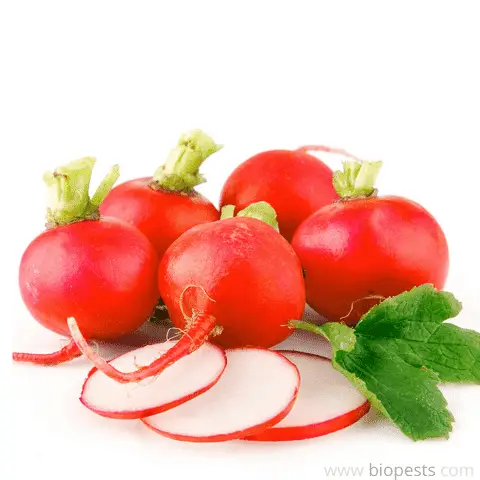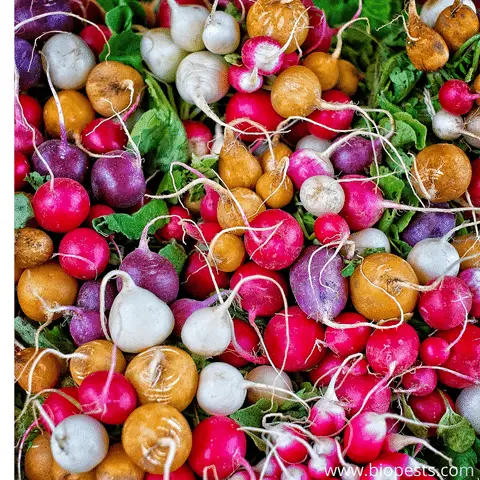Radishes are loved, hated, or tolerated. Radishes are fast-growing root vegetables with a slightly spicy and peppery taste. They are a good source of vitamin C and antioxidants and have numerous health benefits, including reducing your risk of diabetes. But, if you’ve ever grown or tasted store-bought radishes, you may have come across a radish that tastes like soil and wondered why.
Radishes taste like soil for a few reasons: being left in the ground too long, taste perception not being washed sufficiently, and soil impurities. Because radishes are root vegetables, they tend to naturally have a slightly earthy taste. Some may perceive this as tasting like soil.
Radishes are easy to grow but, like most vegetables, can be prone to growing problems and disease. Radishes are cool-season vegetables and prefer soils that are well drained. A few radish varieties include the Cherry, Belle, Easter Egg, White, and Champion radish. If you’re an avid gardener or just trying to incorporate more radishes into your diet, you’ll want to know why they taste like soil.

What Makes Radishes Taste Like Soil?
There are a few reasons that make radishes taste like soil. While there are specific guidelines around growing radishes to ensure they thrive and taste as they should, some may have a loamy soil-like taste.
Root vegetables like radishes taste like soil for the following reasons:
| Why Radishes Taste Like Soil | |
| Reason | Explanation |
| 1. Soil microbes or bacteria | Radishes that pick up bacteria and soil microbes may taste like soil and have an earthier, dirt-like taste. This is because fertilizers and soil naturally contain these microbes and bacteria, which can influence the taste of radishes. |
| 2. Bio compounds | Bio compounds like geosmin are produced if the soil’s pH is high or the ground has a high alkalinity level. The production of geosmin can also cause radishes that taste like soil. |
| 3. Insufficient watering | Radishes grow quickly and require sufficient water. They tend to pick up a soil taste if they have insufficient water. |
| 4. Not being washed properly | A simple reason why radishes can taste like soil is due to improper washing. Ensure your radishes are washed well to get rid of the soil taste. |
| 5. Taste perception | Each person has their own taste preferences. If you’re eating radishes and suddenly find they taste like soil, it could be due to taste perception. |
| 6. Not harvested at the right time | Radishes that are harvested too soon or too late may taste like dirt. The best time to harvest radishes is usually 3 weeks after planting for most radish varieties. |
Are Radishes That Taste Like Soil Fine To Eat?
Radishes that taste like soil are entirely safe to eat. However, if radishes have been left in the ground too long, their texture will be less spongy and may have visible cracks. If the soil taste does bother you, you could try rinsing the radishes or soaking them in salt water to try and eliminate the soil taste.
When radishes aren’t planted in suitable soil, they become woody. However, when planted in loose, deep, and well-drained soil, they have the ideal soil conditions for growing and will be spicy and crisp when harvested.
If you cook your radishes, they are unlikely to taste like soil. However, adding herbs and spices like garlic and dill can help mask some of the earthiness of radishes when cooked.

How To Get Rid Of The Soil Taste In Radishes
To get rid of the soil taste in radishes, you can soak them in cold water or rice water. Some people like adding salt to the water and soaking the radishes to eliminate the soil taste. In most cases, the soil taste will subside when cooked. Still, in some instances, like when cooking soup, it may linger unless the radishes are soaked beforehand.
If you’re planting radishes and want to ensure they don’t taste like soil, plant them in the right season and give them enough space to grow. Your radishes should also get enough water and be harvested around 3 weeks after planting.
Here are a few tips to successfully plant and grow radishes and avoid them tasting like soil:
- Plant radishes during the correct season. The best season to plant radishes is in early spring or fall.
- Watering. Radishes need frequent watering to grow. Ideally, one inch of water per week is the best, but if the top layer of soil seems very dry, you can add more water. If there is rainfall, you can continue to water once a week; if there is no rainfall, increase the watering twice a week.
- Prevent pests. Radishes are susceptible to pests like aphids, flea beetles, and root maggots. An organic pesticide will help protect radishes from pests.
- Choosing suitable soil. Radishes can grow in most soils but prefer well-drained and loose soil. This type of soil is the best to yield a good crop of radishes.
- Harvesting radishes. If radishes are kept in the ground past their ideal harvesting time, they can become rigid and have a starchy taste. Radishes can be harvested around 3 weeks after planting, but some may take longer depending on the type of radish.
If you want to know which types of radishes are the spiciest, check this out!
How To Cook Radishes To Eliminate The Soil Taste
Radishes have a few incredible health benefits and can be a great addition to any healthy diet. Some people may not enjoy the taste of radishes, especially if they have a soil taste, but there are ways to cook them to make them taste better.
They can be sauteed to eliminate the soil taste in radishes and make them taste similar to delicious roast potatoes. Sauteed radishes have a soft potato-like texture when you bite into them. Although they don’t taste like potatoes, sauteed radishes are just as delicious.
If you prefer crispy radishes, you could fry them.
Spicy radishes can be roasted to tone down the spicy taste and mask earthy flavors.
If you prefer raw, crunchy radishes with their signature spicy flavor, you can slice them thinly and add them to a summer sandwich or salad. To remove the soil taste from the radishes before using them raw, soak them in cold water.
You could also pickle, ferment, braise and grill radishes to get rid of their soil taste.
How To Tell If Radishes That Taste Like Soil Are Bad?
If you’ve bought or harvested radishes and they taste like soil, you may wonder, have they gone bad? And how do you tell if radishes that taste like soil are past their expiry date?
Radishes should be eaten soon after being harvested as they don’t have a long shelf life. If your radishes are stored at room temperature and haven’t been cut yet, they will only last 3 days.
Radishes stored in the fridge can last between 8 days and 2 weeks.
To tell if your radish has gone bad, you should check the following:
- Scent. Radishes don’t typically have an odor; if they start to smell foul, it’s a sign they have gone off and should not be eaten.
- Appearance. Radishes retain their vibrant color when harvested. If your radishes have dark spots, mold, or signs of rot, they may be bad. Some slight imperfections can be cut off, and the radishes can still be eaten.
- Texture. Freshly harvested radishes are firm. If the radishes begin to get mushy or soft, they have likely gone bad.
Does How You Grow Radishes Make Them Taste Like Soil?
The method of growing radishes plays a role in tasting like soil. Radishes are known to be cool-season vegetables but can be grown throughout the year. However, the radishes may crack and have an unpleasant taste if the conditions are not ideal.
Radishes need 8 hours of direct sunlight every day, with some shade. Radishes grow best in fertile soil with a pH of 5.5 to 6.8.
Compost added to the soil beforehand will help provide the earth with the nutrients needed to yield a good harvest of radishes. In addition, the quality of the ground impacts how well the radishes grow and can be a determining factor in your radishes tasting like soil. If you are growing radishes in a pot, this potting soil mix works really well. It is loaded with nutrients and you won’t be disappointed.
Radishes thrive in moist, rich environments and require sufficient watering. Radishes that are grown in soil that is too wet can give them a soil taste. If the soil is too dry, the radishes also tend to dry out, impacting how they taste.
Harvesting radishes at the right time is imperative. Radishes left too long in the ground before being harvested can become spongy, split, crack, and can become very spicy. On the other hand, if left in the ground too long, they are more likely to taste like soil. Most radishes can be harvested in 30 days, but the winter variety is generally harvested between 50-70 days.
Radishes harvested when the temperatures are hot are known to have a more bitter taste. The hotness of a radish varies depending on when it’s harvested and the type of radish it is.
Did you know that there are more than 30 types of radishes? In this article, I mentioned a few examples of the spiciest ones. They all come in different colors, tastes, and shapes, and can be really fun to grow them all!

Conclusion
Radishes taste like soil for many reasons; these include lack of watering, improper washing, and harvesting too late. Despite this, there are ways to get rid of the soil taste and enjoy radishes.
Radishes that have a slightly earthy and soil-like taste are entirely safe to eat. Radishes can also taste like this due to organisms found in the ground they are grown in.
If you are a radishes lover, check out these articles!
Why Radishes Get Worms? Tips On How To Solve This Problem
Which Radishes Are The Spiciest? What Makes Them Spicy
Radish Vs. Horseradish. What’s The Difference?
Some of the links above are affiliate links, meaning, at no additional cost to you, I will earn a commission if you click through and make a purchase.

